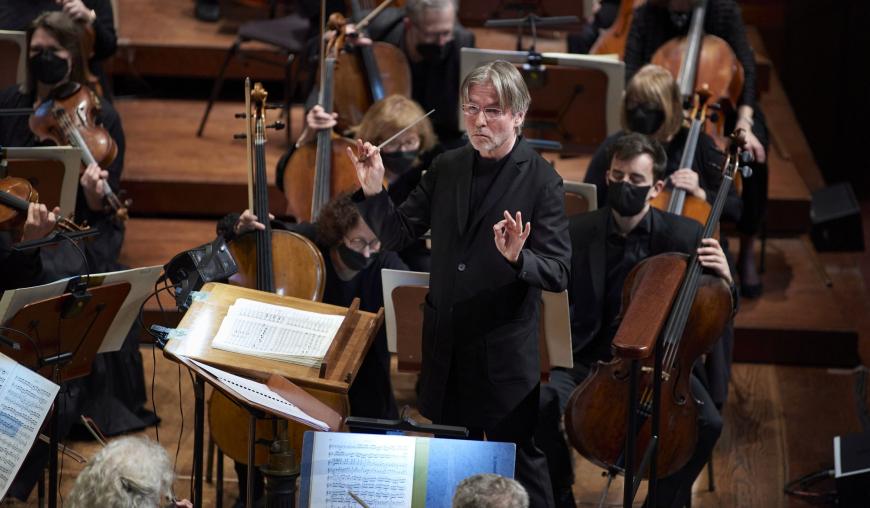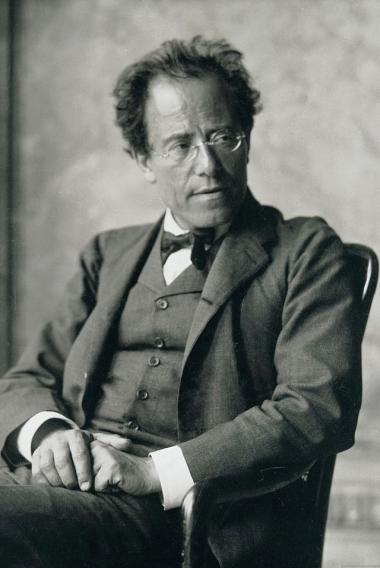
Music Director Esa-Pekka Salonen chose to end this year’s San Francisco Symphony season with Gustav Mahler’s Symphony No. 3. I heard the first performance at Davies Symphony Hall on Friday, June 28.
Salonen has a long history with Mahler’s Third. The concert that first brought him to fame as a conductor, at age 25 in 1983, was a performance of this work with London’s Philharmonia Orchestra. Ironically enough, he was substituting then for an indisposed Michael Tilson Thomas, whom he’d succeed at the SF Symphony in 2020. MTT is famous in the Bay Area for his interpretations of Mahler. What would Salonen do with the composer?
The Third is Mahler’s longest symphony, though not his most intimidating to listen to. Mahler divides the piece into two parts. Part 1 is just the first movement, which is by far the longest and most dramatic. Mahler separates it from the five-movement Part 2 by requesting “a long pause.” Salonen followed this instruction by sitting in a chair on the podium, facing away from the audience, for about one minute. Rather than being a period of contemplation, however, the time was filled with the orchestra tuning up again and a torrent of late-arriving audience members heading for their seats.

The pause notwithstanding, Mahler’s division of his symphony into two parts was not Salonen’s. Part 1 of Salonen’s Third was the first three movements. These were as tight, fierce, and punchy as possible. The music growled, thumped, swirled, and built up to thundering climaxes. The musicians were fully dedicated to this approach. The performance was vivid and captivating, without any lapses into garrulousness. The solos jumped out with distinctive clarity, even to a listener far back in the hall. The hushed posthorn solo in the third movement, played here by Aaron Schuman on cornet, was a dramatic highlight.
It's unconventional to class the second and third movements as action-packed dramatic structures along with the first. General perception of this symphony regards the four middle movements as small-scale, lighter-weight intermezzos. Salonen achieved the connection by emphasizing the forte outbursts in the second and third movements — which Mahler is prone to include in even his quietest and slowest music — and by leading the rest of the music in the same manner as the more peaceful interludes in the first movement.
Those interludes came out as little lakes of momentary calmness in the first movement’s brutality. Salonen managed the heft of this massive movement by dividing it into clearly marked sections with a clear interrelationship. The overall structure stood out. This made the long span digestible and comprehensible, exploiting Mahler’s variety of tempers to best advantage. At no point did Salonen indulge in the coy gemütlichkeit mood, so common in Mahler performances, that can become cloying. Everything was serious and tight. A marching band episode came out with the same crabbed intensity that Charles Ives would have brought to it.
This is completely unlike how MTT approaches Mahler. His Third, as I’ve heard him conduct it, is subdued and impressionistic, melding the styles of the sections, indeed of the movements, instead of separating them and marking out the contrasts. I prefer Salonen’s perspective.
Salonen’s Part 2 was completely different in style. Gravity replaced drama in this slow and dignified performance. To be sure, there are outbursts of anguish and fury in these movements as well, but they were not emphasized here.
The brief fourth and fifth movements featured mezzo-soprano Kelley O’Connor, the ideal soloist. Her deep, strong voice was the perfect match for Salonen’s solemn and awestruck view of the music, carrying out to the audience as the instrumental soloists had.
In the fifth movement, O’Connor was joined by the sopranos and altos of the SF Symphony Chorus and by the young singers of Pacific Boychoir Academy. The “bimm bamm” vocal bell sounds and the lyrics’ allusion to heavenly joy were less bright and cheerful than in other performances, but the choruses sang excellently, and all was clear and beautiful.
The large concluding movement, initially for strings alone (with the rest of the orchestra gradually joining in), was taken with full commitment to Mahler’s “Sehr langsam” (Very slow) tempo marking. Despite huge climaxes, the movement was calm and peaceful, sailing through the vast expanse of time serenely and ending the work with a sense of satisfied fulfillment. As with the rest of the symphony, this was Mahler at his absolute best.




